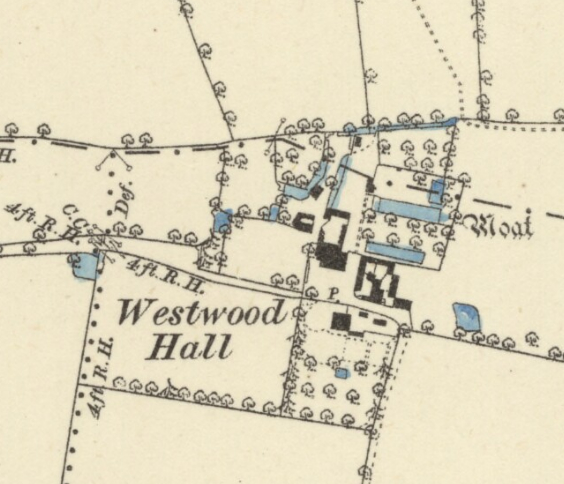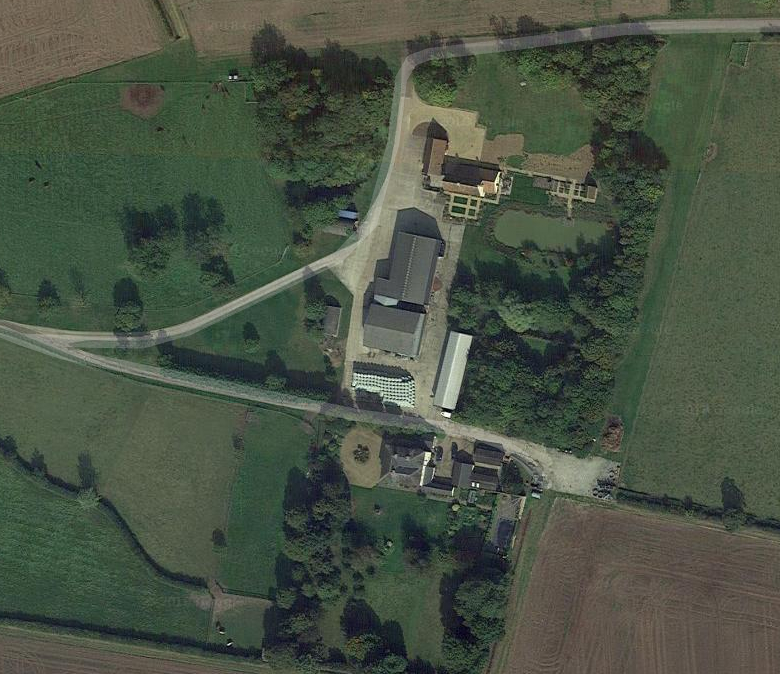(site of, now ‘The Cottage’)
Parish: STONHAM PARVA
District Council: MID SUFFOLK
TM 106 625
Not open to the public
The site of Westwood Hall straddles the parish boundaries of Stonham Parva and Mendlesham to the north and lies in an isolated position surrounded by farmland high on the flat Suffolk clayland plateau. The buildings and most of the gardens are now in Stonham Parva, also known as Little Stonham – ‘Little’ being the translation of the Latin ‘Parva’. The village of Stonham Parva is c. 2.5km (1.5mls) to the south of Westwood Hall just to the west of the A140, the Roman road between Ipswich and Norwich, and c. 10km (6mls) north-east of Stowmarket. Part of an early-seventeenth century house (Grade II), now known as ‘The Cottage’, is all that remains of the original Westwood Hall that is recorded as being a moderately large house with nine hearths in 1674. Today it has a surviving cross-passage, service cell and carved oak pediment over the entrance door with the inscription ‘B.G. 1650’ for a gentleman, Barnaby Gibson (1625–1706). Now a farmhouse, ‘The Cottage’ has been extended and the site includes modern agricultural buildings and a later brick house to the south that has now taken the name Westwood Hall and is in separate ownership.


Although previously thought of as part of a moated complex, it is now believed there are two surviving parallel garden canals running approximately east to west, one of which is brick-lined. Approximately 24m (79ft) apart, the larger, which is to the east of the remains of the old Westwood Hall, is c. 48m (158ft) x 11m (36ft) and the other c. 46m (151ft) x 8m (26ft). The tithe map of 1839 shows the canals within a ‘garden and orchard’ and they may represent the remains of an Anglo-Dutch-style formal water garden. A further pond to the north is believed to have originally been a drainage ditch and to the north-west is a pond that may be the remains of a moat.
Barnaby Gibson (1625–1706) was first cousin to Edward Sheppard Esq. of Ashe High House – now called Campsey Ashe House – in Campsea Ashe, Suffolk and by marriage was related to Edward Mann of Boundary Farm, Framsden where similar canals exist. It seems likely that the much grander gardens of the Sheppard family, whose status rose with the marriage of Edward Sheppard’s son John to the Dowager Countess of Leicester, were an influence on their ‘lesser’ relatives at Framsden and Stonham Parva. At Campsea Ashe the longest canal is flanked by a surviving terrace and yew hedge that would once have been accompanied by formal beds, hedges, statues and urns. This may be an indication of features that accompanied the canals at Westwood Hall, although there is no evidence of these today. The canals may have been the work of Barnaby Gibson’s son (1659–1719) or grandson (1685–1758), both also named Barnaby.
SOURCES:
Martin, Edward, Garden Canals in Suffolk in East Anglia’s History: Studies in Honour of Norman Scarfe, 2002.
Martin, Edward, Easton, Timothy and McKechnie, Ian, ‘Conspicuous Display: The Extraordinary Garden and Buildings of a Minor Gentry Family in Mid-Suffolk’ in Suffolk Institute of Archaeology and History, Vol XXXVII, Part 1, 1993.
https://stonhamparvapc.org.uk/parva-and-pye/history/ (accessed February 2024).
Maps:
1838 map and apportionments.
1884 (surveyed 1884) OS map.
1905 (revised 1903) OS map.
1952 (revised 1950) OS map.
2024 Google aerial map (Imagery © Bluesky, CNES / Airbus, Getmapping plc, Infoterra Lts & Bluesky, Maxar Technologies, Map data © 2024).
Heritage Assets:
Suffolk Historic Environment Record (SHER): SVA 001.
Former Farmhouse 100 metres North of Westwood Hall (Grade II), Historic England No: 1033195.
Suffolk Record Office (now Suffolk Archives):
SRO (Ipswich) K681/1/427/2. Harvest gang of old men and young women during the war at Westwood Hall, c. 1916.
Site ownership: Private
Study written: March 2024
Type of Study: Desktop
Written by: Tina Ranft
Amended:
